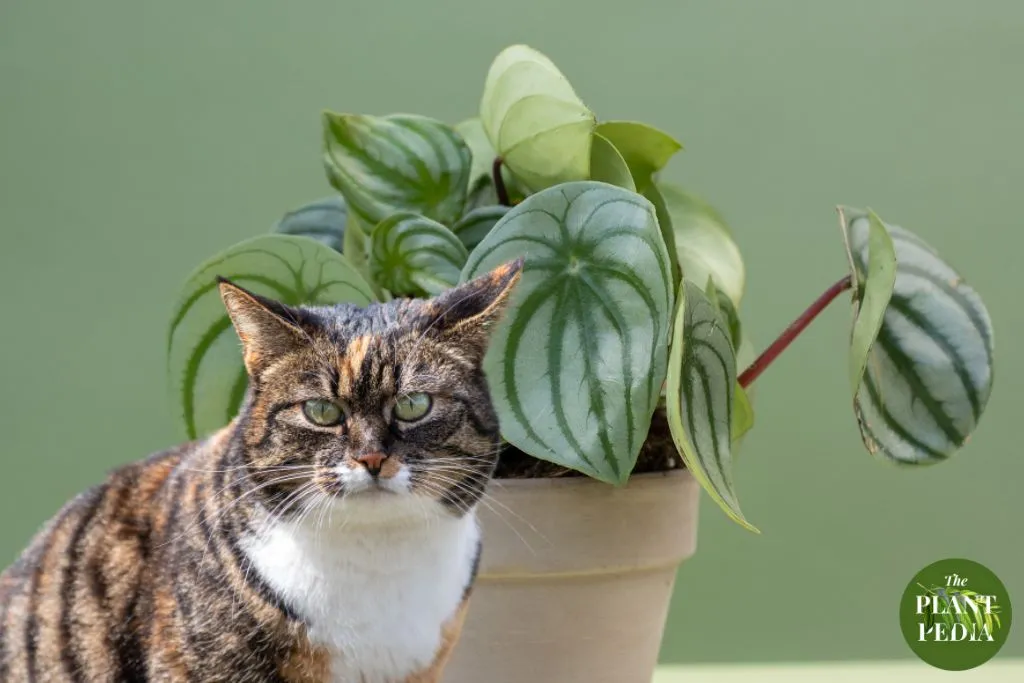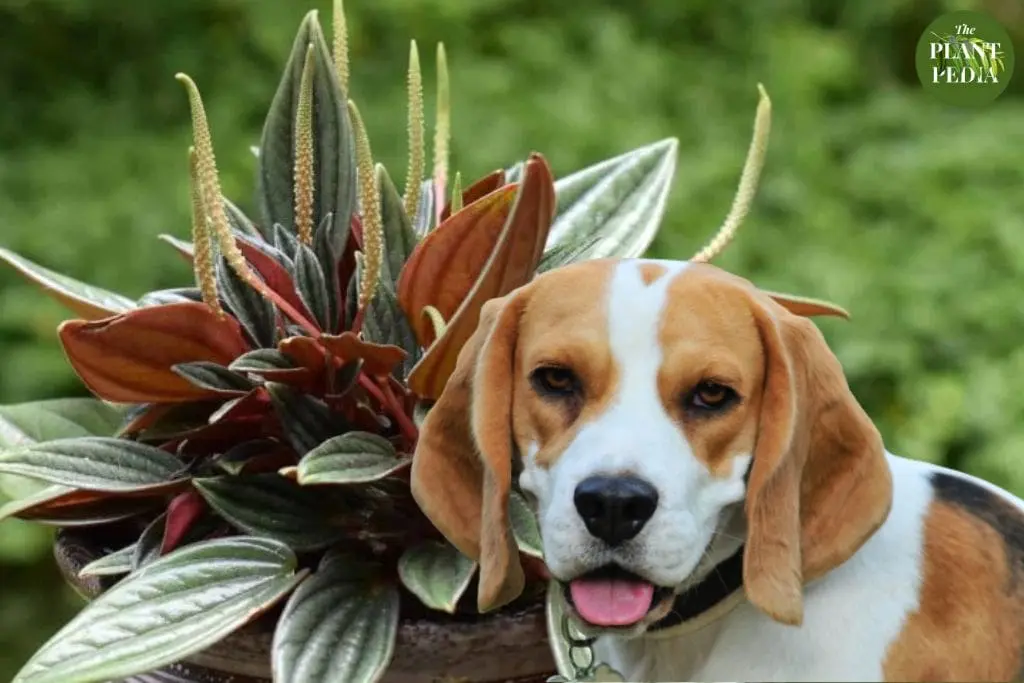In the world of indoor gardening, the allure of lush greenery knows no bounds. Houseplants bring life, color, and a touch of nature into our living spaces, creating an atmosphere of tranquility.
However, for pet owners, the introduction of plants into the home comes with a significant responsibility: ensuring the safety and well-being of their furry companions.
Among the myriad of houseplant options available, peperomia has gained popularity for its unique foliage and easy-care nature.
But the pivotal question remains: Is peperomia toxic to cats? In this comprehensive exploration, we will dive into the depths of this topic, examining scientific evidence, understanding the nuances of peperomia plants, and unraveling the truth about their interaction with our feline friends.

Table of Contents
Is Peperomia Toxic to Cats?
No, peperomia is not toxic to cats. According to reputable sources such as the American Society for the Prevention of Cruelty to Animals (ASPCA) and other pet poison control organizations, peperomia is considered non-toxic to both cats and dogs.
This means that if your cat ingests part of a peperomia plant, it is unlikely to experience any negative side effects.
However, it’s important to note that while peperomia is generally safe, individual pets may react differently, and ingesting any plant material in large quantities could still lead to gastrointestinal discomfort.
Remember, not all plants within the same genus share the same properties. Pet owners should exercise caution and verify the specific variety’s safety before introducing it to their living spaces.
To ensure your cat’s safety, it’s always a good practice to keep houseplants out of reach of pets and to monitor their behavior around plants.

Also read: Is Peperomia Toxic to Dogs? (Radiator Plant Toxicity).
Understanding Peperomia Plants
Peperomia belongs to the Piperaceae family, a diverse group that encompasses over 1,000 species with a wide range of leaf shapes, colors, and patterns.
Originating from tropical and subtropical regions, peperomia plants have adapted well to indoor environments, making them popular choices among plant enthusiasts.
The appeal of peperomia lies not only in its aesthetic qualities but also in its relatively low maintenance requirements.
Also Read: Peperomia Care (Radiator Plant): A Complete Guidelines.
Common Varieties of Peperomia
To better understand the potential effects of peperomia on cats, it’s crucial to explore some common varieties of this plant.
Peperomia obtusifolia, also known as the Baby Rubber Plant, features glossy leaves and a compact growth habit. Peperomia caperata, or Emerald Ripple, displays unique wrinkled leaves that add texture to indoor spaces.
Other notable varieties include Peperomia argyreia (Watermelon Peperomia) with its distinctive silver-striped leaves and Peperomia ferreyrae (Happy Bean) characterized by its succulent-like appearance.
Cats and Plant Interaction: An Overview
Cats are naturally curious creatures, and their penchant for exploration often extends to plants within their environment.
While peperomia is considered non-toxic, it’s important to recognize that cats may still exhibit interest in chewing or playing with plants.
While some cats may simply investigate the foliage without ingesting it, others might take a nibble out of curiosity.
Thus, responsible pet ownership involves more than just understanding a plant’s toxicity; it requires taking preventative measures to ensure a safe coexistence between pets and plants.
Concerns About Peperomia Toxicity
Despite the non-toxic classification, it’s worth delving deeper into the concerns that may arise in the context of peperomia and cat interaction.
Even non-toxic plants can potentially cause mild gastrointestinal upset if ingested in significant quantities. Additionally, individual cats may react differently to plant consumption, leading to varying degrees of discomfort.
While peperomia toxicity is unlikely, it’s important to remember that the term “non-toxic” doesn’t equate to “completely harmless.”
Identifying Potential Toxic Compounds
To comprehensively address concerns about peperomia toxicity, it’s worthwhile to identify the compounds that could potentially cause harm to cats.
Some plants contain compounds that, while not deadly, can still lead to digestive discomfort. Peperomia plants, however, do not appear to contain any known compounds that are significantly harmful to cats.
This absence of harmful compounds contributes to their non-toxic classification.
Signs of Peperomia Toxicity in Cats
Given that peperomia is non-toxic, the occurrence of signs specifically attributed to peperomia toxicity is rare.
However, it’s crucial for cat owners to recognize the signs of plant consumption in general.
These signs may include drooling, vomiting, diarrhea, lethargy, and changes in appetite or behavior.
While peperomia is unlikely to cause such symptoms, swift action is necessary if these signs manifest.
Immediate Steps if Ingestion Occurs
If a cat does ingest a significant amount of plant material, whether peperomia or any other plant, immediate steps should be taken. Contacting a veterinarian is the most prudent course of action.
The veterinarian can assess the situation and provide guidance on whether further medical attention is needed based on the cat’s condition and the plant ingested.
Safe Alternatives for Cat-Friendly Homes
For pet owners who prioritize safety without compromising the aesthetic appeal of their homes, there are numerous non-toxic plant options available.
Some of these include:
- African Violet
- Boston Fern
- Burro’s Tail (Sedum morganianum)
- Christmas Cactus (Schlumbergera)
- Echeveria and Hens & Chicks (Sempervivum)
- English Ivy (Hedera helix)
- Peace Lily (Spathiphyllum)
- Spider Plant (Chlorophytum comosum)
- Watermelon Peperomia (Peperomia argyreia)
Precautions for Pet Owners
While peperomia is deemed safe for cats, taking precautions is paramount. To ensure the well-being of both your pets and your plants, consider the following:
- Plant Placement: Position plants in areas that are less accessible to cats. Hanging planters or elevated shelves can help keep plants out of reach.
- Behavioral Enrichment: Provide alternative sources of entertainment for your cats, such as interactive toys, scratching posts, and designated play areas.
- Supervision: Monitor your cat’s interactions with plants and discourage chewing or nibbling behavior.
- Educate Yourself: Research the specific peperomia variety you intend to bring home. While peperomia as a whole is non-toxic, individual species may have slight variations in their properties.
Related FAQs:
Are all peperomia species safe for cats?
While the majority of peperomia species are safe for cats, it’s advisable to research the specific variety you’re interested in before bringing it into your home.
While no toxic compounds have been identified in peperomia plants, individual cats may react differently, and it’s always best to exercise caution.
Is Peperomia Polybotrya toxic to cats?
No, Peperomia polybotrya is not toxic to cats. As we mentioned before, all Peperomia plants are considered to be non-toxic to both cats and dogs, according to the American Society for the Prevention of Cruelty to Animals (ASPCA).
How can I determine if a specific peperomia variety is safe for my cat?
Reputable sources such as the ASPCA’s database of toxic and non-toxic plants can be consulted to verify the safety of a particular peperomia variety.
Additionally, seeking guidance from local nurseries or plant experts can provide valuable insights.
What are some safe peperomia varieties for cat-friendly homes?
Many peperomia varieties are considered safe for cats. Some popular options include Peperomia obtusifolia (Baby Rubber Plant), Peperomia caperata (Emerald Ripple), and Peperomia argyreia (Watermelon Peperomia).
However, it’s always prudent to research and verify the safety of any plant before introducing it to your home.
Should I avoid certain peperomia varieties just to be safe?
While the majority of peperomia species are non-toxic, some pet owners may prefer to err on the side of caution and avoid plants that are less well-researched or documented.
Opting for the well-known and widely accepted safe varieties can help alleviate concerns.
What precautions should I take if I’m unsure about a peperomia variety’s safety?
If you’re unsure about the safety of a specific peperomia variety, consider placing the plant in an area that is out of your cat’s reach.
Additionally, closely monitor your cat’s behavior around the plant. If you notice any signs of interest or attempts to nibble, it might be best to relocate the plant.
Can cats have allergic reactions to peperomia plants?
While peperomia plants are generally safe for cats, some sensitive individuals might still experience mild allergic reactions.
These reactions could manifest as skin irritation or mild digestive upset. If you observe any unusual behavior or symptoms, consult a veterinarian for guidance.
Conclusion
The question of whether peperomia is toxic to cats is one that holds great significance for pet owners seeking to create harmonious indoor environments.
With thorough research and reliance on reputable sources, we can confidently conclude that peperomia plants are indeed non-toxic to cats.
However, responsible pet ownership transcends mere classifications. It involves understanding your cat’s behavior, taking preventative measures, and promptly addressing any signs of distress.
While the allure of peperomia’s vibrant foliage is undeniable, creating a safe haven for your feline companions should always remain a top priority.


